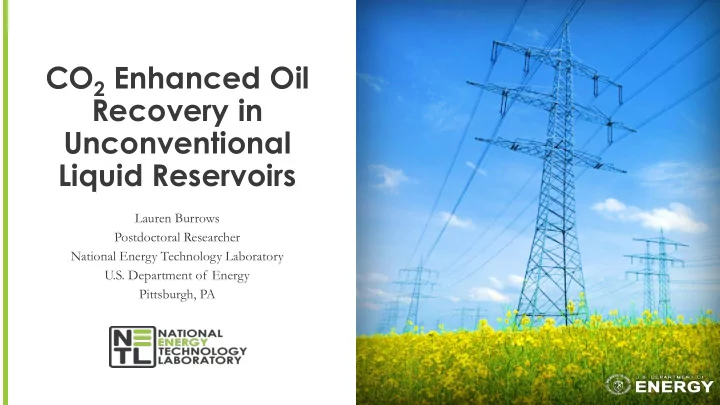

CO 2 Enhanced Oil Recovery in Unconventional Liquid Reservoirs Lauren Burrows Postdoctoral Researcher National Energy Technology Laboratory U.S. Department of Energy Pittsburgh, PA
Objectives of NETL • Increase domestic energy production (Improve U.S. energy security ,decrease dependence on foreign oil) • Reduce environmental impact of fossil fuels 2
Despite Shale Revolution, much work to be done! • EOR in unconventionals is needed : recovery after hydraulic fracturing + primary production = 4-6% (Bakken) • Permeabilities are 1,000 to 10,000 times lower in than in conventional reservoirs • Low permeabilities are caused by low porosity, small pore sizes, oil-wetness 3
Mechanism of CO 2 oil recovery in conventional reservoirs • Conventional and unconventional mechanisms are very different due to the low permeability shale matrix • CO 2 EOR in conventionals: CO 2 easily flows through pores • Heavy and light hydrocarbons are both produced, no soak time needed 4
Mechanism of CO 2 Enhanced Oil Recovery in Fractured Shale Reservoirs • Diffusion is a key mechanism: long soak times improve recovery, lighter hydrocarbons produced preferentially Some CO 2 enters CO 2 flows through pores, driven by fractures, driven high injection by high injection pressures pressures Injection pressure Oil and CO 2 in equilibrates and fractures move to CO 2 enters pores production well by diffusion 5
Implications of diffusion mechanism Diffusion High exposed shale Long soak mechanism of surface area improves times CO 2 EOR in ULRs recovery improve oil recovery Lighter hydrocarbons High injection pressures beyond are produced MMP improve oil recovery preferentially 6
Fluids being considered for EOR in Fractured Shale Reservoirs Attribute CO CO 2 Eth thane Meth thane Nitr itrogen Water Kinetic diameter (nm) 78, 79 0.33 0.44 0.38 0.36 0.27 Critical temperature, ° C 31 32 − 83 − 147 374 Critical pressure, Mpa 7.4 4.9 4.6 3.4 22.1 Critical Density (g/cm 3 ) a 0.47 0.21 0.12 0.31 0.32 Viscosity (cP), 100 ° C, 20.7 MPa a 0.039 0.038 0.018 0.025 0.29 MMP, Bakken oil (MPa),110 ° C 80 17.4 9.3 31.1 101.4 - Swells oil? Significant Significant Yes No No Reduces oil viscosity? Significant Yes Yes No No Contaminant if present in produced oil/gas? Yes No No Yes Yes Forms acid in water? Yes No No No No Advantageous for oil recovery Moderate effect on oil recovery Disadvantageous for oil recovery 7
CO 2 and Nat. Gas are both viable gases for EOR in Shale Rich natural gas (~15% C 2 +) and CO 2 yield similar oil recovery in lab- scale huff ‘n puff experiments 11 mm diameter rods from Middle Bakken, 110 °C, 5000 psi, Hawthorne et. al., 2017 8
CO 2 and Nat. Gas are both viable gases for EOR in Shale Nat. Gas in Eagle Ford (Hoffman, 2018) Eagle Ford Bakken Formation Injectivity Good Good EOR Natural gas Slight increase in Results injection production, increased regardless of fluid production* Problems Conformance control issues, early CO 2 in Bakken (Hoffman, 2016) breakthrough, influence of nearby wells unknown *No comparison to CO 2 reported. Pilot tests do not clearly show which high- pressure gas is better for oil recovery. 9
Lab tests are overly optimistic Oil Recovery (%) CO 2 is allowed to surround entire core Confined Core Huff n’ Puff 1. 2. Soak 3. Confined cores to better model field conditions Core Volume / Surface Area Exposed to CO 2 (cm) NETL Pittsburgh: CO 2 Morgantown: natural gas Surface area to volume ratio in laboratory At-depth cores from Eagleford is high, does not correspond to field 10
Combined strategy-surfactants for EOR in unconventionals • Surfactants are commonly used in waterflooding (conventionals) and fracturing fluid (Unconventionals) • Surfactants improve hydrocarbon recovery by: (1) Decreasing interfacial tension (IFT) between oil and water (2) Changing surface from oil-wet to water-wet 11
CO 2 -soluble surfactants for CO 2 EOR CO 2 -soluble surfactants have already been studied for CO 2 foams Nonionic surfactants are inexpensive and commercially available Combine the advantages of low viscosity CO 2 with the IFT and wettability-altering capabilities of surfactants Shale 947 µm Oil 1230 µm Oil-philic segment Oil-phobic 1060 µm segment segment CO 2 + surfactant 12
Our experimental plans: CO 2 EOR using shale cores • Pump, transfer vessel and soaking vessel are in place, setup completed • Shake down with Berea in decane completed • Experimental procedures : Huff n’ Puff with confining pressure -setup in progress • Oil analysis: Filtering the Eagle Ford oil, SARA analysis 13
Conclusions • Natural Gas and CO 2 are both viable fluids for EOR in Unconventionals • Use of CO 2 or natural gas largely depends on cost and availability • Laboratory core floods for EOR in Unconventionals are more optimistic than field results • We are using confined, “at - depth” cores for CO 2 EOR experiments • Will combine the benefits of CO 2 with wettability-altering surfactants Angela Goodman Bob Enick (U. Pitt.) Lauren Burrows Sean Sanguinito Physical Chemist Chemical Engineer Organic Chemist Geologist Deepak Tapriyal Foad Haeri Patricia Cvetic Fan Shi Chemical Engineer Petroleum Engineer Chemical Engineer Materials Scientist Dustin Crandall Barbara Kutchko Geochemical Engineer Mechanical Engineer 14
Recommend
More recommend